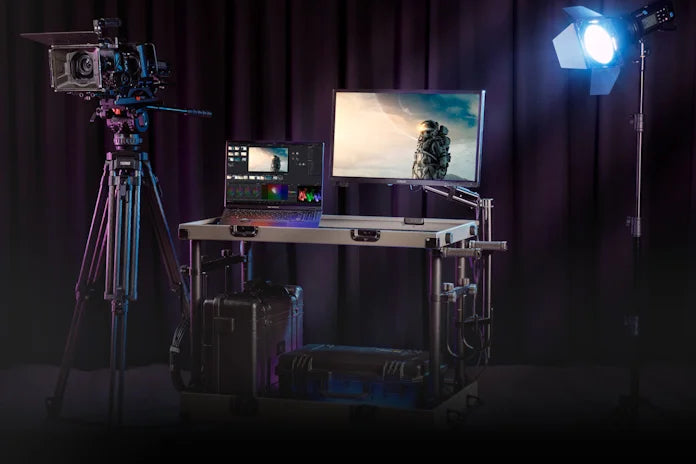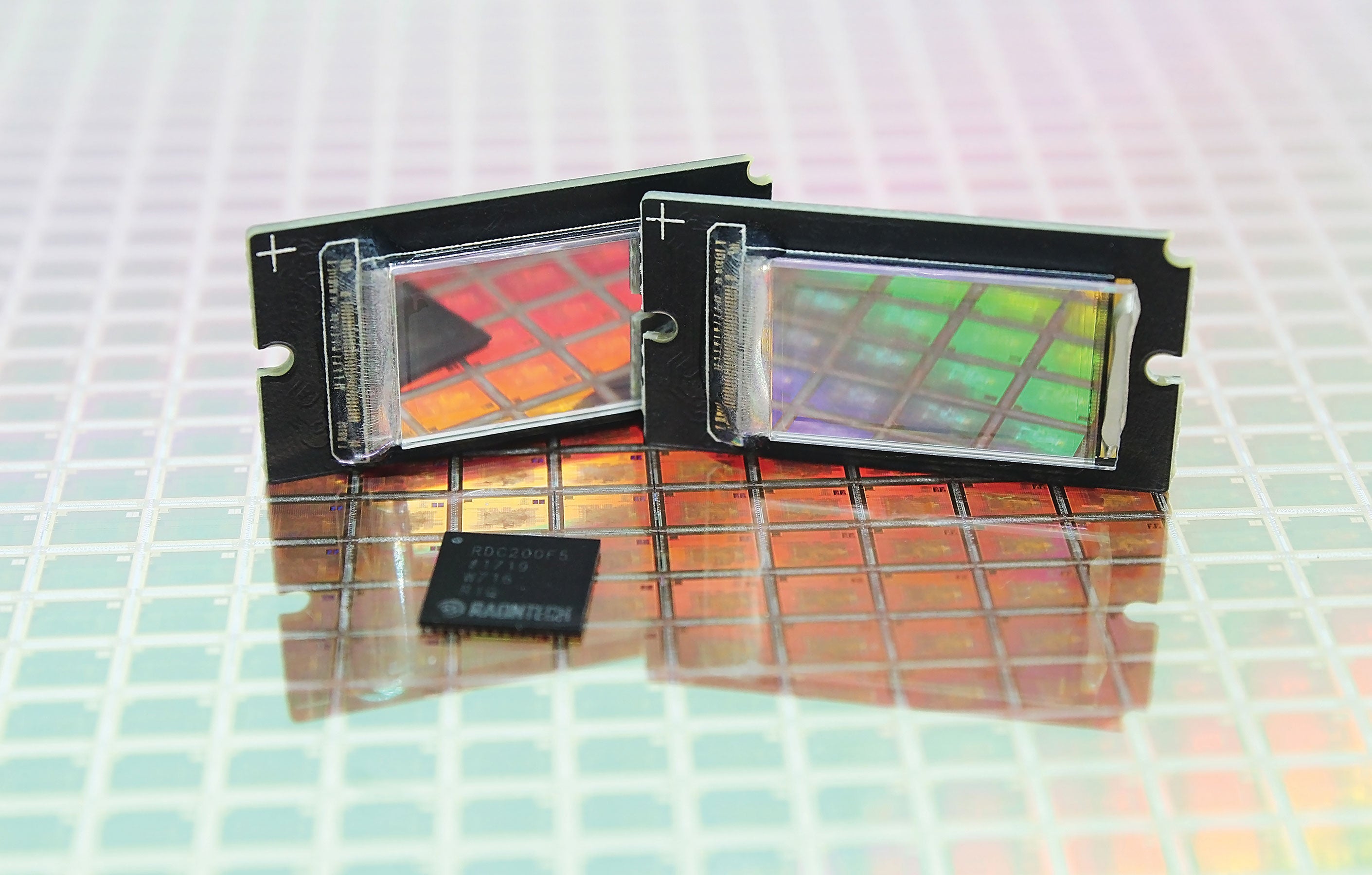Micro OLED Display, or OLED-on-Silicon, merges organic LEDs with silicon backplanes, boasting ~5000 PPI pixel density for ultra-sharp output; its structure uses RGB sub-pixels driven by silicon TFTs, while optics leverage self-emission, with ~25% light extraction efficiency boosted by micro-lenses.
Silicon Backplane Basics
Over 90% of consumer Micro OLEDs (think AR glasses or VR headsets) rely on them because silicon’s electron mobility is 1400 cm²/V·s—1400 times higher than glass’s 1 cm²/V·s—enabling the ultra-tiny circuits needed for 5000 PPI or more. For an AR display hitting 5000 PPI, that silicon backplane manages microscopic circuits lighting each pixel without lag.
Silicon backplanes begin as single-crystal silicon wafers—50-100 micron slices of ultra-pure material, thinner than a human hair. Temperature tolerance: during OLED manufacturing, evaporation coats the backplane at 300-400℃. Silicon’s crystalline structure stays rock-solid here—tests show its electrical resistance varies less than 0.5% even after 2 hours at 400℃. Glass? It warps, and its resistance spikes over 5%, ruining display consistency. Worse, glass fails entirely above 300℃.
Every Micro OLED pixel has its own TFT: a microscopic light switch controlling on/off states and brightness. Mainstream silicon backplanes pack over 100,000 TFTs per square millimeter—100 times denser than a printed circuit board—and switch in less than 1 microsecond.
Compare that to glass: its low electron mobility forces bigger circuits, limiting pixels to over 10 microns and max resolution to under 2000 PPI. Silicon? Its <1 micron line widths (from semiconductor lithography) let pixels shrink to under 5 microns—enabling 6000+ PPI.
Making a silicon backplane is complex—15+ photolithography steps, each aligning patterns with ±0.2 micron accuracy—but yield is high (~95%), keeping costs manageable. And because silicon combines the substrate and driver circuitry, it cuts display thickness by 50% and cost by 30% versus LCDs with separate driver chips.
Take a real example: a top AR headset uses a 1-inch silicon backplane Micro OLED. Its 5000 PPI density and 1 million:1 contrast ratio come from silicon’s precisionPlus, the backplane’s ultra-flat surface (<0.5 nanometer roughness) means perfect anode contact, reducing leakage current by 10% and extending lifespan by 10%.
Cost-wise, silicon backplanes make up 30-40% of a Micro OLED’s total cost, but brands pay for the payoff: a 5000 PPI Micro OLED lets an AR glasses company charge twice as much as a competitor with a lower-res LCD.
RGB Subpixel Layouts
RGB subpixels are the microscopic color dots that bring Micro OLEDs to life—over 95% of high-resolution displays (think AR glasses or VR headsets) rely on them to achieve 5000 PPI or higher. Each subpixel measures just 4-5 microns wide—smaller than a grain of fine sand—and a 1-inch 2K panel crams 6 million of them (2 million red, 2 million green, 2 million blue) to eliminate color fringing.
These triads sit side by side horizontally with subpixel spacing under 1 micron. For a 5000 PPI display, this spacing is critical: wider gaps cause visible color banding. Triads also deliver strong color accuracy with a ΔE of around 2.5—indistinguishable to most users (ΔE below 2 is lab-grade “perfect”).
This vertical arrangement simplifies driver circuits: each column of subpixels shares a single data line, slashing response time to 1 microsecond (versus 1.5 microseconds for triads). That’s a huge win for VR—faster response eliminates blur when tracking a virtual object at 90 frames per second. Stripes also push PPI higher—up to 6000—since vertical subpixels occupy less horizontal space. The tradeoff? Color accuracy dips slightly to ΔE ~3.0.
Suddenly, green subpixel density doubles compared to red or blue—and that matters because human eyes are 10 times more sensitive to green light (we perceive brightness primarily from green). Delta layouts boost green resolution, making images sharper and brighter: a delta display can hit 7000 PPI (higher than triad or stripe) and increase brightness efficiency by 15%—a 1000 nit panel uses 10% less power than a triad layout. ΔE ~1.8. Manufacturing complexity: delta layouts demand ±0.1 micron alignment precision (versus ±0.2 for triads)—but modern CMOS tools keep yields high at around 92%.
Real-world use cases highlight these differences: A top-tier AR headset using delta layout delivers 7000 PPI density and 1000 nit brightness, keeping outdoor maps crystal clear while the 15% power savings adds an extra hour of battery life. A gamer’s VR headset with stripe layout benefits from 1 microsecond response time, wiping out blur when dodging virtual bullets at 90 fps. And a $200 budget AR device? Triad layout—cheaper to produce, still hitting 5000 PPI for checking messages or streaming videos.
TFT Pixel Driving
TFT pixel driving is the silent workhorse making Micro OLEDs sharp and snappy—each of the 6 million subpixels in a 1-inch 2K display has its own thin-film transistor (TFT) switch, toggling pixels on/off in less than 1 microsecond with 99.9% accuracy. That’s why Micro OLEDs eliminate motion blur at 90 fps, while older LCDs drag with 10ms response times.
Every pixel’s TFT connects two key lines: a gate line (which tells the TFT to open/close) and a data line (which sends current to light the OLED). For a 1-inch 2K panel, that means 1024 gate lines and 1024 data lines crisscrossing the wafer.
Their electron mobility of 1400 cm²/V·s—10 times higher than amorphous silicon’s 140 cm²/V·s. That lets them drive pixels as small as 4 microns (for 5000 PPI) without slowing down. Contrast that to early AMOLEDs using poly-silicon TFTs: their 50 cm²/V·s mobility forced larger pixels (over 10 microns) and capped resolution at 2000 PPI. Silicon TFTs don’t just fit more pixels: a 0.8 microsecond rise time means pixels reach full brightness almost instantly, critical for VR where head movements need instant visual feedback.
Take current precision: each pixel’s TFT regulates current to within 5% error, ensuring brightness uniformity across the screen. A 1-inch panel with 98% brightness consistency avoids hot spots or dim patches—something budget LCDs struggle with (their error rates hit 15%). Then there’s gray-level accuracy: silicon TFTs hold voltage steady for 1024 gray levels, hitting ΔE ~2.2 for colors—indistinguishable to most users (ΔE < 2 is lab-perfect).
Low-power TFT designs keep static power consumption below 1 mW/cm² (when the display is idle) and dynamic power under 5 mW/cm² (when showing video). For an AR headset, that adds 1–2 hours of battery life compared to older TFT tech. CMOS fabrication gives TFTs a 10,000-hour lifespan with <10% performance degradation.
Real-world numbers tell the story: A top VR headset uses silicon TFTs with 1 microsecond switching. At 90 fps, that means the display updates every 11ms. Its TFTs hold current accuracy to 3%, ensuring surgical overlays stay crisp and reliable. Even budget AR glasses benefit: their 0.9 microsecond TFTs hit 5000 PPI without breaking the bank.
That integration cuts display thickness by 50% and cost by 30% versus LCDs with separate driver ICs.

OLED Emission Basics
OLED emission is the core magic making Micro OLEDs sharp, vivid, and compact—unlike LCDs that need backlights, these organic diodes emit their own light, switching on in less than 1 microsecond (10x faster than LCDs) and measuring just 1–2 microns thick. That’s why a 1-inch display can weigh under 1 gram and hit 1 million:1 contrast.
Every OLED pixel is a tiny functional sandwich: an ITO-coated silicon anode (from the backplane) on top, a magnesium-silver cathode on the bottom, and 10–15 organic layers in between—totaling 1–2 microns thick. These layers work in sync: the hole transport layer (HTL) moves positive charges from the anode, the emission layer (EML) blends red, green, and blue organic emitters (like Alq3 for green or Ir(ppy)3 for red), and the electron transport layer (ETL) shuttles negative charges from the cathode. When current flows, electrons and holes collide in the EML, and that’s electroluminescence. This process takes 400–500 nanoseconds—instant enough for VR headsets tracking 90 fps head movements, where lag would make you feel sick.
Power efficiency is a game-changer: OLEDs convert 20–30% of electrical energy to light (LCDs waste 90% on backlight heat). A 1000 nit white pixel uses just 15 mW—half as much as an LCD’s 30 mW. Over a year of daily 2-hour use, that saves 3650 mWh. Lifetime is equally impressive: modern OLEDs use stable emitters to hit 100,000 hours before brightness drops to 50%—27 years of 10-hour days, far longer than most devices last.
Green emitters are 25 nm wide (LCDs are 50 nm), so colors look pure. A Micro OLED covers 100% of DCI-P3, wider than sRGB’s 72%—reds pop, greens glow, and blues feel deep, making movies or gaming in AR feel immersive. Its TFTs regulate current to each pixel—holding it to ±2% error.
-
Organic layers: 10–15 thin films between anode and cathode—each tuned to move or emit charges.
-
Total thickness: Just 1–2 microns—thinner than a human hair—making displays lightweight and flexible.
-
Emission speed: 400–500 nanoseconds per pixel—faster than LCDs’ millisecond response, critical for VR/AR motion clarity.
-
Power efficiency: 20–30% energy-to-light conversion.
-
1000-nit power use: 15 mW per white pixel—LCDs need 30 mW for the same brightness.
-
Lifetime: 100,000 hours to 50% brightness—27 years of daily 10-hour use, way beyond device lifespans.
-
Color range: 100% DCI-P3 coverage—wider than sRGB’s 72%—for vivid, accurate visuals.
-
Contrast: 1,000,000:1—no backlight bloom means deep blacks and bright highlights coexist.
-
Burn-in risk: Minimal—static elements fade evenly, no permanent image retention like old OLED TVs.
Micro Lens Enhancement
Micro lenses are tiny, pixel-matched convex optics that squeeze more brightness out of Micro OLEDs—~25–30% more light reaches your eye vs. bare pixels, solving OLED’s biggest flaw: wasting light that scatters sideways instead of going to your eye. For a 4-micron OLED pixel, a 12-micron lens (thinner than a hair) sits right on top, turning scattered photons into usable light for slimmer headsets or sunnier days.
Every OLED pixel emits light in alldirections—only ~20% travels straight to your eye, the rest bounces off the backplane or leaks out sideways. Micro lenses fix that with basic optics: a 12-micron acrylic or silicone lens curves to refract side light toward your viewing axis. This tiny tweak boosts light extraction efficiency from 20% to 25–30%—meaning a 1000 nit panel now hits 1300 nit outdoors, where older Micro OLEDs would look washed out like a foggy phone screen.
The real-world payoff? Less power, better visibility, and sharper images. A VR headset with micro lenses uses 20% less power to maintain 1000 nit brightness—saving 1.5 mW per pixel, which cuts 6-hour battery drain by 10% (enough for an extra 36 minutes of gaming). For AR glasses, the lens slashes 40% of side blooming: a bright virtual menu icon no longer lights up the edges of your vision, making text on a sunny street readable without squinting.
Manufacturing these lenses is hyper-precise: companies use UV lithography or inkjet printing to coat each pixel with a lens, holding ±1 micron alignment accuracy. But yields are high (~98%), so adding micro lenses only bumps wafer cost by $0.50 per chip—a steal for 30% more brightness.
Take a real AR navigation headset: its micro lenses push outdoor brightness to 1300 nit and contrast to 1.5 million:1. Virtual arrows on a trail stay sharp against sunlight, and black backgrounds stay deep. Higher efficiency means the headset runs brighter at 90 fps without draining the battery faster, reducing eye strain during long sessions.
En lire plus

Micro OLED displays, leveraging silicon-based OLEDoS technology on compact CMOS backplanes, deliver ~5000 PPI density for ultra-sharp visuals, ideal for AR/VR; their HDR excels with up to 1,000,000...

Micro OLED elevates AR/VR with over 3000 PPI to slash screen-door effect, under 10ms latency curbing motion sickness, and AMOLED architecture—boasting self-emissive pixels with 1,000,000:1 contrast...



Laisser un commentaire
Ce site est protégé par hCaptcha, et la Politique de confidentialité et les Conditions de service de hCaptcha s’appliquent.